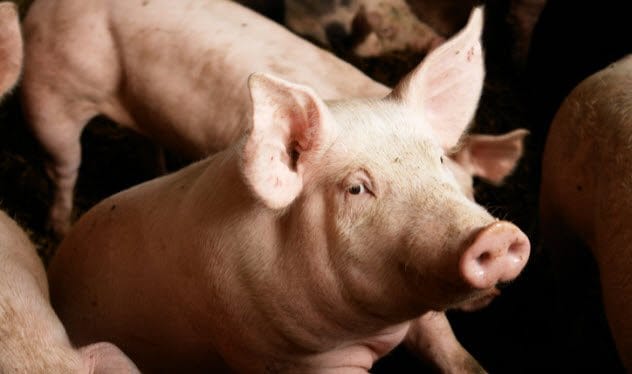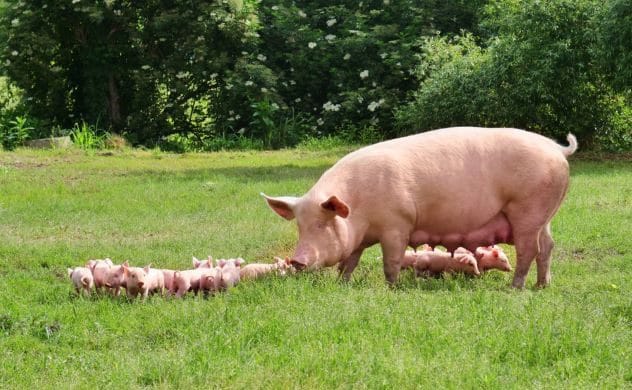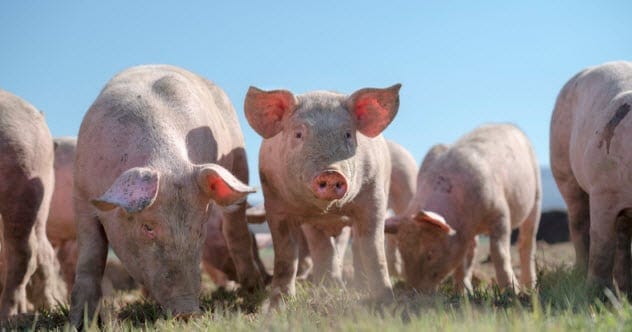Introduction
Pigs are often seen as simple farm animals, content with mud and a good meal. However, these curious creatures play a surprisingly significant role in the world of scientific development. Scientists across various fields rely on our porcine friends to push the boundaries of knowledge. While some experiments are lighthearted, like teaching AI to detect a pig’s stress levels, others delve into more complex and sometimes controversial areas, including organ transplants, gene editing, and cloning. From innovative insemination techniques using coconut water to groundbreaking cross-species heart transplants, pigs have helped us uncover remarkable insights. Let’s explore ten of the most fascinating—and occasionally ethically challenging—ways pigs contribute to modern science.
10. Bionic Patch Aids Erectile Dysfunction in Boars

Aging affects everyone, and sometimes, things just don’t work as they once did. Believe it or not, even pigs can experience difficulties in the romance department. But there’s new hope thanks to a bionic patch designed to address these issues. In January 2023, Chinese researchers introduced a technology called artificial tunica albuginea (ATA) to help boars maintain erections. This device cleverly mimics the penis’s complex tissue microstructures, providing support without breaking. This allows damaged members to function properly again and achieve arousal.
While it will take time before similar patches can be used for humans, the research team is hopeful. They believe their invention could significantly aid male reproduction in the future, offering a potential solution for a common problem.
9. Synthetic Glue: A Potential Treatment for Lactose Intolerance

Conditions such as lactose intolerance, diabetes, and obesity can greatly impact daily life. Scientists at MIT propose that a unique synthetic glue could offer a solution. This special adhesive attaches to the small intestine’s wall, helping to regulate how nutrients are absorbed. The gut is crucial for nutrient uptake, but Giovanni Traverso and his team observed that it doesn’t always absorb as much as it could. Inspired by how mussels cling to wet rocks, they developed a chemical glue.
But how does one get glue safely into the small intestine? The MIT team devised a drink containing the glue’s chemical components. These ingredients only combine when they encounter an enzyme specific to the small intestine, forming an adhesive substance called polydopamine. Tests on pigs showed that this glue could enhance the absorption of various nutrients depending on its chemical makeup. For instance, adding lactose improved lactose digestion by up to 20 times. Mixing the polydopamine lining with nanoparticles led to reduced glucose intake in pigs, which could be revolutionary for treating diabetes and obesity, both linked to excess glucose.
8. Genetically Altered Pig Heart Transplants: Innovation or Ethical Dilemma?
In the summer of 2022, a significant medical event occurred: two brain-dead patients in New York received genetically modified pig hearts. Surgeons successfully performed this intricate procedure, known as a xenotransplant, without any immediate signs of organ rejection. Over three days of careful monitoring, the new hearts functioned well, and neither patient contracted any diseases from the transplant.
Scientists at New York University made ten genetic modifications to the pig hearts. Six alterations involved adding human genes to promote healthy growth and reduce rejection risk, while the other four modifications blocked certain pig DNA sequences. This wasn’t the first time pig heart transplants made headlines. Months earlier, 57-year-old David Bennet received the first xenotransplant at the University of Maryland Medical Center. Bennet, who suffered from terminal heart disease, unfortunately, passed away two months after the procedure, possibly due to an infection from the new organ.
These experimental surgeries, while fascinating, are surrounded by controversy. Ethical concerns arise about whether scientists are overstepping boundaries. Additionally, many animal rights activists oppose this line of research. However, proponents emphasize the severe shortage of donor organs, particularly in the U.S., where the transplant waiting list includes around 106,000 people, and an average of 17 people die each day while waiting for organs. Scientists hope that genetically altered pig transplants could help alleviate this crisis.
7. Pigs Can Absorb Oxygen Through Their Anuses
It might sound unbelievable, but research suggests that pigs can essentially breathe through their bottoms. This surprising discovery emerged when a team of scientists sought a medical alternative to traditional ventilators. When an ICU patient’s oxygen levels drop, doctors often use ventilators to push air into their lungs, but this can risk damaging lung tissue.
Takanori Takebe, a Japanese researcher, believes he has found an alternative method: enabling the body to absorb oxygen through the intestines. His study involved administering fluids into pig anuses. Takebe and his colleagues gave their pig subjects enemas using an oxygen-rich liquid called perfluorocarbon. They observed a significant increase in the pigs’ blood oxygen levels each time the fluid was introduced. The research team believes a similar technique could be used to treat humans, especially in countries where ventilators are less accessible or affordable. Since perfluorocarbon is already used to aid lung development in premature babies, the risk of toxic side effects is considered low.
6. Calcite Analysis Confirms Oldest Animal Cave Painting Features a Pig
This entry is a bit different from the others. It involves not a living pig, but a cave painting of one, believed to be the oldest ever found. Archaeologists discovered this ancient artwork in a remote cave on the Indonesian island of Sulawesi. The painting depicts a Sulawesi warty pig and measures 53.5 inches (136 centimeters) by 21 inches (54 centimeters).
To determine the artwork’s age, scientists used a Uranium-based dating technique. Maxime Aubert noticed a calcite deposit covering parts of the pig painting. Analysis revealed this deposit to be 45,500 years old. However, the painting itself might be even older. “It could be much older because the dating we’re using only dates the calcite on top of it,” Aubert explained. Archaeologists also found two handprints near the warty pig image. Scientists are hopeful that they can extract DNA samples from these handprints, which could provide more insights into the lives of ancient humans.
5. Smart Swine: Pigs Taught to Play Video Games
In 2021, a study published in the Frontiers in Psychology journal described an intriguing experiment: teaching pigs to play video games. The participants included two Yorkshire pigs named Hamlet and Omelette, and two Panepinto micro pigs named Ebony and Ivory. Researchers at Purdue University trained these animals to use a joystick with their snouts.
The game presented on the screen was simple, yet the four pigs showed surprising skill. Each time they successfully used the joystick to move a cursor toward a target, they received a food pellet as a reward. Interestingly, even when the treats were withheld, the pigs continued to play. Scientists described this research as “remarkable,” suggesting that pigs possess greater intelligence and cognitive abilities than previously thought. Dr. Candace Croney, an author of the study, noted, “It is no small feat for an animal to grasp the concept that the behavior they are performing is having an effect elsewhere. That pigs can do this to any degree should give us pause as to what else they are capable of learning and how such learning may impact them.”
4. Controversial Blood-Splatter Study Involving Pigs
The use of animals in scientific research often sparks debate, especially when it involves procedures like those in a 2015 New Zealand study. This research, which aimed to study blood-splatter patterns, involved shooting pigs in the head and made international headlines.
While many of the pigs’ heads were sourced from butchers, the researchers used five live adult pigs for part of the experiment. These animals were sedated, secured to a table, and then killed using a pistol or a semi-automatic rifle. Three pigs were shot from a distance of 4 feet (1.2 meters), while the other two were shot at point-blank range. The Institute of Environmental Science and Research stated that, despite the seemingly cruel nature of the experiment, it provided crucial insights into “gunshot-related back spatter.” This information can be vital in helping to solve gun crimes. When a bullet enters the head, biological material like blood, tissue, and bone fragments often spurt backward from the entry wound—but not always. The pig-shooting study investigated why this back spatter occurs inconsistently and the factors influencing it. Understanding blood-splatter patterns helps forensic experts differentiate between scenarios like murder and suicide.
3. Facial Recognition Technology to Monitor Pig Well-being

A fascinating scientific experiment is underway to better understand the emotions of farm animals. Researchers at the Pig Research Centre, part of Scotland’s Rural College (SRUC), believe their findings could lead to significant improvements in pig welfare.
In 2019, SRUC launched a new project that uses facial recognition technology to determine if an animal is content or distressed. As part of this study, the team created detailed 3D and 2D images of pig faces. These images are then analyzed at the University of the West of England. There, researchers are developing innovative methods to interpret a pig’s emotional state based on its facial expressions. Although the technology is still in its developmental stages, scientists are optimistic. They suggest it could eventually be used on farms to flag health complications or welfare issues early. “Machine vision technology offers the potential to realize a low-cost, non-intrusive, and practical means to biometrically identify individual animals on the farm,” explained machine vision expert Melvyn Smith. “Our work has already demonstrated a 97% accuracy at facial recognition in pigs. Our next step will be, for the first time, to explore the potential for using machine vision to automatically recognize facial expressions that are linked with core emotion states, such as happiness or distress, in the identified pigs.”
2. Novel Insemination Technique Boosted by Coconut Water

For many, coconut water is a refreshing, tropical beverage, perfect for a hot day. However, scientists in Uganda have discovered a far more unexpected application for this drink: artificial insemination in pigs.
Researchers at Gulu University are pioneering this unusual technique, hoping it can be adopted across Africa. Water from young coconuts is naturally rich in essential nutrients like sodium and potassium. Using this fluid to deliver semen into a sow is believed to improve the chances of fertilization by enhancing sperm motility and longevity. Improving pig insemination is especially important in a country like Uganda, where the annual pork demand is approximately 7.5 pounds (3.4 kilograms) per person. The research team hopes their findings will offer smallholder farmers an affordable and accessible method to raise higher-quality pigs for meat. Lead researcher Elly Ndyomugyenyi explained, “High concentration of sodium and potassium in the green coconuts are factors which help in sperm motility and longevity. Coconut fruits are readily available in the local markets. They are sold like other local fruits.”
1. AI Robots Achieve Autonomous Pig Cloning
Artificial intelligence (AI) and cloning represent two of the most debated frontiers in modern science. When these two fields intersect, they create a complex web of ethical considerations. Despite this, in June 2022, scientists announced a groundbreaking achievement: the first litter of piglets cloned entirely by robots, without any human intervention.
This milestone was accomplished by a research group at Nankai University in Tianjin, China. They assert that their research demonstrates that removing humans from the cloning process significantly reduces the margin for error. According to the team, these AI-powered machines are more successful at cloning pigs than human technicians. Researcher Liu Yaowei told reporters, “Each step of the cloning process was automated, and no human operation was involved. Our AI-powered system can calculate the strain within a cell and direct the robot to use minimal force to complete the cloning process, which reduces the cell damage caused by human hands.” This development points towards a future where complex biological procedures could be largely automated, potentially increasing efficiency and success rates.
Conclusion
Pigs, often underestimated, are proving to be invaluable in the realm of scientific exploration. From aiding in the development of bionic solutions for erectile dysfunction and novel treatments for lactose intolerance to their controversial roles in organ transplantation and forensic science, these animals are at the forefront of many amazing discoveries. We’ve seen how their unique physiology allows for unconventional research, such as oxygen absorption through the intestines, and how their cognitive abilities are being explored through video games. Even ancient depictions of pigs are helping us understand human history. As technology advances, with AI now capable of cloning pigs, the ethical discussions surrounding these experiments will undoubtedly continue. Yet, one thing is clear: pigs are more than just farm animals; they are crucial partners in our ongoing quest for knowledge and innovation.
What are your thoughts on these incredible pig experiments? Which one surprised you the most? Leave your comment below!










